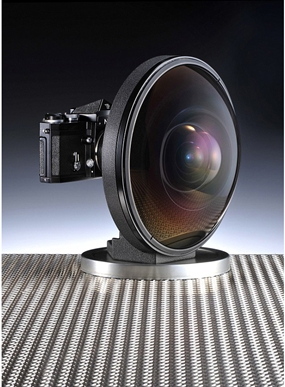Have you ever sat in a Toyota Fortuner fitted with the trick special rear vision mirror mounted on the front passenger mudguard to assist the driver in parking? The mirror is around 200 mm back from the front of the vehicle, and yet it lets you see the very front of the car. Fascinating optical technology.
However, I only recently came across a camera lens which has a 220 degree field of vision. Remembering back to geometry, 180 degrees is the field of vision you have from one side of your head to the other. You cannot look behind you at the same time. But this lens does, just like the Fortuner mirror, this lens was built by Nikon in 1970. Forty years ago this optical technology was already being used.

It is known as the Fisheye-Nikkor 6 mm f2.8 lens, first shown in 1970 at the Photokina trade show in Cologne, and held the distinction of not only offering an angle of view of 220 degrees, but also being known at the time as the world’s most “extreme wide-angle” lens, and which it still is, forty years later! The lens officially went into production in 1972 and uses multi glass elements in nine groups with a total weight of more than 5 kg. This extremely wide-angle lens from Nikkor is also extremely rare and I only became aware of it when it was offered by Grays of Westminster in the UK for £100,000 GBP (approximately $161,400 USD, or 5 million THB) for those of you with the deep pockets.
The specifications of this lens include:
Focal length/Aperture: 6 mm f2.8
Lens construction:12 elements in 9 groups
Picture angle: 220 degrees
Diaphragm: Automatic
Aperture scale: f2.8-f22 on both standard and aperture-direct readout scales
Exposure measurement: Via full aperture method; meter coupling ridge provided for AI cameras and meter coupling shoe for non-AI cameras
Distance scale: Graduated in meters and feet from 0.25m (0.9 ft.) to infinity (00)
Weight : 5,200 gm
Dimensions: 236 mm diameter x 171 mm long (overall); 160 mm extension from lens flange
Filters: Built-in: skylight (L1BC), medium yellow (Y 48), deep yellow (Y52); orange (056), and red (R60)
Front lens cap: Slip-on
Those with an interest in photographic history will remember that this extreme wide lens was introduced around the same time as the longest reach Nikkor lens – the 2,000 mm f11 Reflex Nikkor. Now that is a monster, and Nikkor then possesses not only the widest angle, but also the longest reach in 35 mm photography.
Its specifications are:
Focal length/Aperture: 2000 mm f11; Lens construction: 5 elements in 5 groups
Picture angle: 1°10′; Diaphragm: None; Aperture scale: None
Exposure measurement: Via stop-down method
Distance scale: Graduated in meters and feet from 18m (60ft.) to infinity (00)
Dimension: 262 mm x 598 mm
Filters: 4 types Built-in: ultraviolet (L37C), medium yellow (Y48), orange (056), and red (R60)
Weight: 17,500g
However, neither of these lenses are ones you will see the local pro-shooter pulling out of his bag. The practicality is not there, even though both lenses deliver what you would expect from such ‘ultimate’ optics. Both are very heavy lenses and their use could be described as cumbersome. Finally, since it is not an entirely day to day usage optic lens, they are only made available through special order. This ultimate fish-eye+ lens is more of a status symbol than a viable commercial application lens for photography. More of a Rolls-Royce, when a Toyota Fortuner will do!
But 5 million baht will get you a nice house, a Mercedes-Benz or four Fortuners. It is impossible to justify the purchase of a lens such as this, though the technology that produced it can be looked upon in awe.
But once again, for those who wish to achieve certain optical objectives and if price is not an important issue, it does fulfill many objectives such as situations where you need a high performance wide angle lens with extreme wide coverage to use for low available light photography, or fulfilling scientific and researchers aspirations, this lens is indeed a dream lens for them. Or even looking behind yourself to see where you have been!




